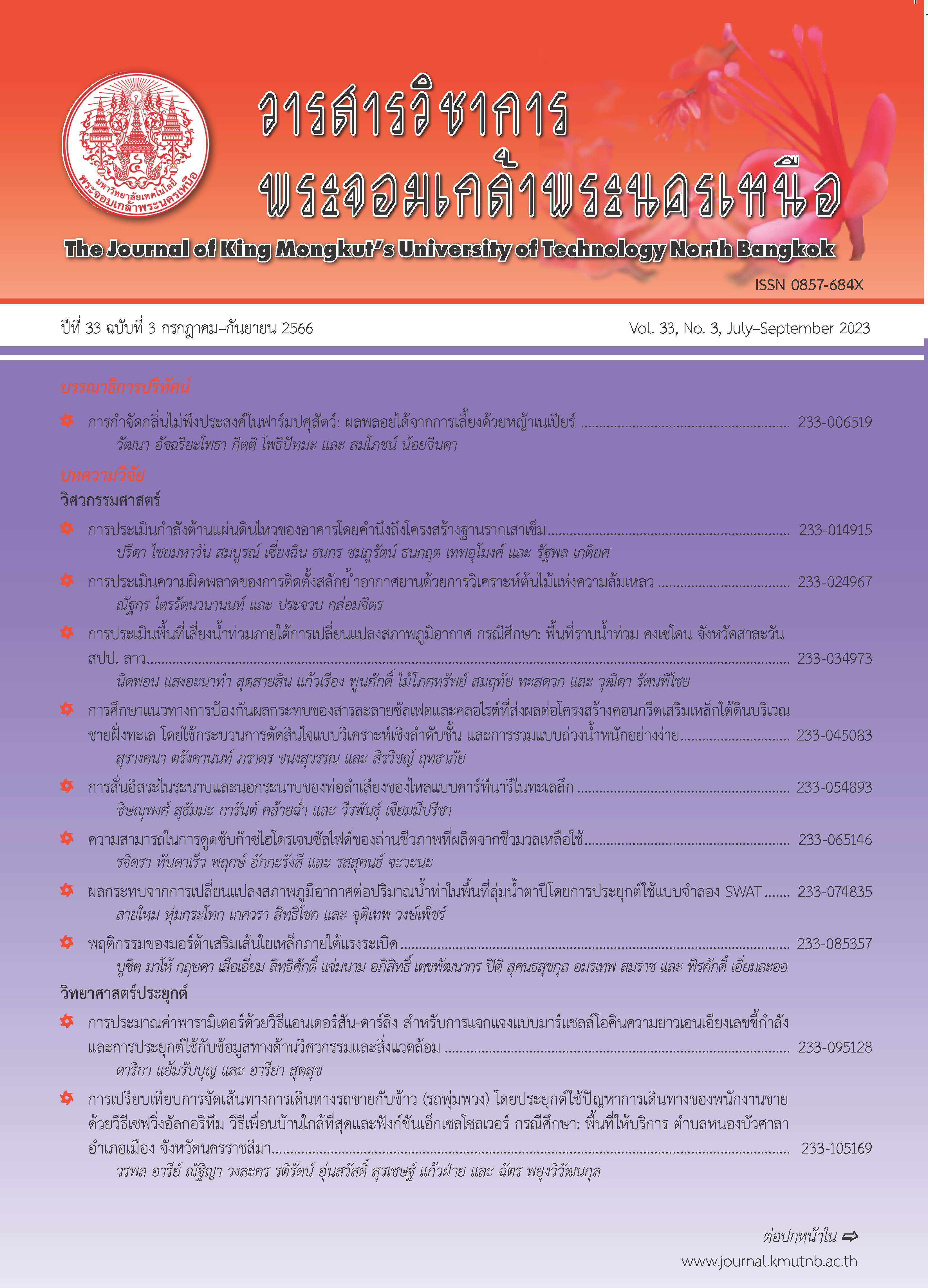การเปรียบเทียบการจัดเส้นทางการเดินทางรถขายกับข้าว (รถพุ่มพวง) โดยประยุกต์ใช้ปัญหาการเดินทางของพนักงานขาย ด้วยวิธีเซฟวิ่งอัลกอริทึม วิธีเพื่อนบ้านใกล้ที่สุดและฟังก์ชันเอ็กเซลโซลเวอร์ กรณีศึกษา พื้นที่ให้บริการ ตำบลหนองบัวศาลา อำเภอเมือง จังหวัดนครราชสีมา
Main Article Content
บทคัดย่อ
รถขายของชำ (รถพุ่มพวง) มีบทบาทในต่างจังหวัดของประเทศไทย โดยเฉพาะช่วงวิกฤตการณ์ไวรัสโควิด-19 ที่คนไทยส่วนใหญ่ต้องอยู่บ้าน อย่างไรก็ตาม การไม่วางแผนเส้นทางทำให้สิ้นเปลืองค่าใช้จ่ายและเวลา นอกจากนี้ การเร่งทำเวลาการให้บริการทำให้มีการขับรถย้อนศร ซึ่งผิดกฎจราจรและอาจเกิดอุบัติเหตุได้ งานวิจัยนี้มีวัตถุประสงค์เพื่อจัดเส้นทางการให้บริการรถพุ่มพวงโดยประยุกต์ใช้ปัญหาการเดินทางของพนักงานขาย โดยเปรียบเทียบวิธีเพื่อนบ้านใกล้ที่สุด วิธีเซฟวิ่งอัลกอริทึม และการใช้ฟังก์ชันเอ็กเซลโซลเวอร์ ในพื้นที่ตำบลหนองบัวศาลา จังหวัดนครราชสีมา ภายใต้ข้อจำกัด คือ 1) สามารถให้บริการครบทุกจุดบริการ 2) ไม่ละเมิดกฎจราจร และ 3) ระยะทางรวมหลังการจัดเส้นทางควรน้อยกว่าเดิม ข้อมูลเส้นทาง ระยะทาง จุดบริการ และพิกัด รวบรวมด้วย จีโอ แทร็คเกอร์ แอพพลิเคชั่น มีจุดจอด 45 แห่ง (ระยะทางรวม 31.24 กิโลเมตร) โดยเริ่มต้นจากตลาดสดประปา ทั้งนี้ การใช้ฟังก์ชันเอ็กเซลโซลเวอร์แสดงระยะทางสั้นที่สุด ซึ่งระยะทางลดลงร้อยละ 18.85 ขณะที่ วิธีเพื่อนบ้านใกล้ที่สุด และวิธีเซฟวิ่งอัลกอริทึม (เริ่มจากตลาดสดประปา หรือตลาดสุรนคร) มีระยะทางเพิ่มขึ้น ร้อยละ 0.58 ร้อยละ 9.99 และ ร้อยละ 8.77 ตามลำดับ การวิจัยนี้สามารถประยุกต์การจัดเส้นทางรถที่มีลักษณะวิ่งวนเป็นรอบ (มิลค์ รัน) เช่น รถสองแถว หรือรถรับส่งพนักงาน เพื่อเพิ่มประสิทธิภาพการขนส่ง
Article Details

อนุญาตภายใต้เงื่อนไข Creative Commons Attribution-NonCommercial-NoDerivatives 4.0 International License.
บทความที่ลงตีพิมพ์เป็นข้อคิดเห็นของผู้เขียนเท่านั้น
ผู้เขียนจะต้องเป็นผู้รับผิดชอบต่อผลทางกฎหมายใดๆ ที่อาจเกิดขึ้นจากบทความนั้น
เอกสารอ้างอิง
Thais PBS News. (2021, Junuary). Rod Phumpuang double sales after the people stayed at home to stop COVID-19. [Online] (in Thai). Available: https://news.thaipbs.or.th/content/ 290077
E. Osaba, X. S. Yang, and J. D. Ser, “Traveling salesman problem: a perspective review of recent research and new results with bio-inspired metaheuristics,” in Nature-Inspired Computation and Swarm Intelligence Algorithms, Theory and Applications, 1st ed. London, UK: Academic Press, 2020, pp. 135–164.
J. Pekar, I. Brezina, J. Kultan, I. Ushakova, and O. Dorokhov, “Computer tools for solving the traveling salesman problem,” Development Management, vol. 18, no. 1, pp. 25–39, 2020.
W. Y. Liu, C. C. Lin, C. R. Chiu, Y. S. Tsao, and O. Wang, “Minimizing the carbon footprint for the time-dependent heterogeneous-fleet vehicle routing problem with alternative paths,” Sustainability, vol. 6, pp. 4658–4684, 2014.
R. Pitacaso, Metaheuristic to solve the problems of production planning and logistics management, 1st ed. Bangkok: Technology Promotion Association (Thailand-Japan), 2011, pp. 1–17 (in Thai).
K. Jit-eua, “Vehicle routing problem with stochastic demand,” Navaminda Kasatriyadhiraj Royal Air Force Academy, vol. 13, no. 13, pp. 19–24, 2017 (in Thai).
T. Pichpibul and R. Kawtummachai, “A heuristic approach based on Clarke-Wright algorithm for open vehicle routing problem,” The Scientific World Journal, vol. 2013, 2013.
G. Kizilateş and F. Nuriyeva, “On the nearest neighbor algorithms for the traveling salesman problem,” in Proceedings CCSEIT-2013, in Advances in Computational Science, Engineering and Information Technology, 2013, pp. 111–118.
J. Vasilev, “Solving the traveling salesman problem with the alldifferent constraint in MS excel,” in Proceedings ICAICTSEE-2015, 2015, pp. 420–423.
S. Winyangkul, N. Jeenaboonroing, P. Ananaue, N. Chaiwongsakda, P. Kuntawong, N. Muak-Kreua, and T. Jantapoon, “An application of the travelling salesman problem case study: Routing for streetcar tour of the Chiang Rai Municipality,” Industrial Technology Lampang Rajabhat University Journal, vol. 7, no. 12, pp. 85–97, 2014 (in Thai).
W. Sawangyat, “Three alternative approaches to design travelling route case study Ayutthaya,” Journal of Rangsit Graduate Studies in Business and Social Sciences, vol. 4, no. 2, pp. 64–77, 2018 (in Thai).
S. Suksee and T. Meejarern, “Minimization of transportation cost by applying the vehicle routing problem: Case study of car accessory company,” Kasem Bundit Engineering Journal, vol. 9, no. 1, pp. 69–84, 2019 (in Thai).
P. Saelee, W. Wijitpongsa, and H. Puangyam, “The case study of “Ratsamee 2015 Limited Partnership”: A vehicle routing problem solved using linear programming,” Industrial Technology Lampang Rajabhat University Journal, vol. 10, no. 1, pp. 48–59, 2017 (in Thai).
A. Lateh, S. Suthammanon, N. Sirivongpisal, and M. Tehyo, “Solving a vehicle routing problem with time window for transportation service planning for elderly people: A case study of Hatyai District Songkhla Province,” Princess of Naradhiwas University Journal, vol. 11, no. 2, pp. 117–131, 2019 (in Thai).
K. Jitrpornsap and K. Sangdee, “Improvement of the Transportation Route of Ready-To-Drink Dairy Products in Bag Form: Case Study of Pamala Transport Agent in Nakhon Si Thammarat Province,” in Proceedings North Bangkok University National Conference Academic Year 2020, 2020, pp. 141–153 (in Thai).
K. Sueni, “The Routes Transportation by Comparison between Using the Saving Algorithm and the Nearest Neighbor Algorithm,” Economics and Business Administration Journal Thaksin University, vol. 12, no. 2, pp. 1–14, 2020 (in Thai).
J. Gao, F. Gu, P. Hu, Y. Xie, and B. Yao, “Automobile chain maintenance parts delivery problem using an improved ant colony algorithm,” Advances in Mechanical Engineering, vol. 8, no. 9, pp. 1–13, 2016.
T. Karthya and S. Priyanka, “Comparative Analysis of the optimal solutions of Travelling Salesman Problem,” in Proceedings 11th National Conference on Mathematical Techniques and Applications, 2019, pp. 0200301–0200307.
F. Carrabs, R. Cerulli, and A. Sciomachen “An exact approach for the grocery delivery problem in urban areas,” Soft Computing, vol. 21, no. 9, pp. 2439–2450, 2017.
Z. Hashim and W.R. Ismail, “Self-drive tourism route in terengganu: An application of goal programming model,” WR Ismail. Sains Humanika, vol. 9, no. 1–5, pp. 51–57, 2017.

